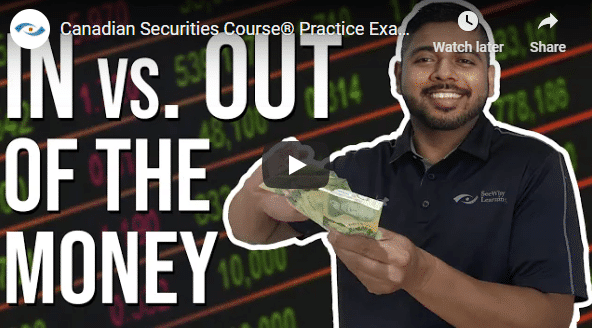Josh here at the Coaches’ Hangout. One of the more challenging concepts in the Securities Course is Derivatives, and more specifically, whether an options contract is “IN the money”, “AT the money”, or “OUT of the money”.
If you have added the eLearning videos to your student account, you will find a lesson where we actually teach you the ins and outs of this concept. But on exam day, you could get confused. So, I am going to show you a neat little trick that will make these types of questions a snap.
In another Coaches’ Hangout video, one of my colleagues gives you some excellent tips on how to memorize the CALL/PUT table, and he encourages you to jot it down the moment your exam begins. I am going to assume you are going to do that. You will see the table below. Let’s tweak it a little bit to help us even more.

The horizontal line in the middle does not move, so we can use it to represent the Strike price or Exercise price of the option. Beside that line, jot down the strike price. Here is the neat little trick. If the market price of the stock goes above that line, the call is “IN the money”. If the market price of the stock goes below that line, the “put” is “IN the money”. The phrase “call up and put down” helps me remember this. It’s really that simple.
Let’s go through a sample question and you will see what I mean.
ABC has an exercise price of $25 and expires in 60 days. What is true of this option if the market price of ABC is $30? A, the call is in the money. B, the call is out of the money. C, the call writer is in the money, and D, the call writer is out of the money. Okay, jot down the exercise price of $25.
As per the trick, the market price of ABC is $30 and is above that line. So, the call is in the money. This allows us to easily eliminate answers B and D, because they both say out of the money. We can also eliminate answer C, because in our out of the money deals with the option itself, not what side of the transaction you’re on.
Consider the following analogy. If you want to check if a lottery ticket is a winner, you would analyze the ticket itself. You would then say the ticket is either a winner or it is not a winner. You don’t need to concern yourself with whether you are the person that bought the ticket or if the retailer holds it.
The same holds true if asked if an option is “IN the money” or “OUT of the money”. Focus on the option itself, not what side of the transaction you are on.
Thanks for dropping by the Coaches’ Hangout. I hope you found this blog post helpful. Keep up the great work and good luck on your exams.

Recent Videos

Monetary & Fiscal Policy Part 2

Monetary & Fiscal Policy





